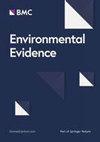Existing evidence of conceptual differences in research on climate change perceptions among smallholders? A systematic map
IF 5.2
4区 环境科学与生态学
Q2 ENVIRONMENTAL SCIENCES
引用次数: 0
Abstract
Climate change is having adverse effects on the livelihoods of small-scale populations, particularly in relation to their subsistence practices. Scientific literature widely acknowledges that smallholders must first perceive climate changes to take necessary precautions and adapt to the new conditions. However, variations exist in the terminology used across the literature, and in how it conceptualizes these perceptions. This variation complicates understanding of the literature and hinders empirical evidence comparisons. Therefore, in this review, we systematically mapped the literature considering variations in the concept's usage across different thematic areas. Our goal was to provide a comprehensive overview of the current state of the literature on smallholder climate change perceptions. In our systematic map, we adhered to the Collaboration for Environmental Evidence guidelines. We searched the literature adopting English terms and using five electronic databases of scientific publications (Web of Science Core Collection, Scopus, BASE–Bielefeld Academic Search Engine, PubMed, and Science Direct Elsevier). We then screened the retrieved articles' titles, abstracts, and full texts according to predefined eligibility criteria. Articles meeting the eligibility criteria were chosen for full reading, data extraction, and coding, utilizing a prepared codebook. No validity appraisal occurred in this selection. A database containing coded metadata for all studies is accessible for reference. After screening 5358 articles (titles and abstracts), we identified and thoroughly reviewed 361 eligible articles at full text to map the usage of the climate change perception concept. Among these, 73 articles provided explicit definitions of perception, falling into seven categories: risk perception, perception based on psychological constructs and sensory stimuli, awareness, prior experience, observation of climate variables, beliefs, and uncertainties or threats. Implicit definitions of perception with various constructs were found, including those rooted in Cognitive Psychology, awareness, risk perception, traditional knowledge, beliefs, concerns about climate change, experiences of exposure to its effects, attitudes, worldviews, and scientific knowledge. Articles usually address multiple topics. Notably, 88% of the articles did not present any theory throughout their content. Geographically, Africa and Asia were the most frequently studied continents, with more focus on non-indigenous small-scale populations than indigenous ones. In conclusion, the perception concept exhibits an interdisciplinary nature. Therefore, fostering continuous dialogue among diverse disciplines is imperative to establishing an interdisciplinary definition of the term. An in-depth understanding of the perception concept is essential, as its absence can result in erroneous conclusions, limited adaptation strategies, and a lack of awareness among small-scale populations regarding climate change impacts. Misconceptions about this concept can lead to ineffective policies, further endangering vulnerable populations. Defining the concept and its constructs facilitates article comparisons. Without this definition, meaningful comparisons become unfeasible. Moreover, the absence of proper perception definitions poses challenges for small-scale populations, researchers, and stakeholders in developing effective, efficient, and flexible adaptations over time. Perception is the first step in incorporating adaptation strategies and must be translated into policies to address climate change impacts efficiently.小农户气候变化认知研究中概念差异的现有证据?系统地图
气候变化正在对小规模人口的生计产生不利影响,特别是在他们的生存方式方面。科学文献普遍承认,小农必须首先感知气候变化,才能采取必要的预防措施并适应新的条件。然而,文献中使用的术语以及如何将这些感知概念化存在差异。这种差异使得对文献的理解更加复杂,也阻碍了经验证据的比较。因此,在本综述中,我们对文献进行了系统的梳理,考虑到了不同主题领域在使用这一概念时的差异。我们的目标是全面概述有关小农气候变化认知的文献现状。在绘制系统地图时,我们遵循了环境证据合作组织的指导方针。我们使用英文术语和五个科学出版物电子数据库(Web of Science Core Collection、Scopus、BASE-Bielefeld Academic Search Engine、PubMed 和 Science Direct Elsevier)对文献进行了检索。然后,我们根据预先设定的资格标准对检索到的文章标题、摘要和全文进行筛选。我们选择符合资格标准的文章进行全文阅读、数据提取和编码,并使用事先准备好的编码手册。在选择过程中没有进行有效性评估。包含所有研究编码元数据的数据库可供查阅。在筛选了 5358 篇文章(标题和摘要)后,我们确定并全面审阅了 361 篇符合条件的文章全文,以绘制气候变化感知概念的使用图。其中,73 篇文章提供了明确的感知定义,分为七类:风险感知、基于心理结构和感官刺激的感知、意识、先前经验、气候变量观察、信念以及不确定性或威胁。此外,还发现了包含各种建构的隐含感知定义,包括认知心理学、意识、风险感知、传统知识、信念、对气候变化的担忧、受气候变化影响的经历、态度、世界观和科学知识。文章通常涉及多个主题。值得注意的是,88%的文章在内容上没有提出任何理论。从地域上看,非洲和亚洲是最常被研究的大洲,非土著小规模人口比土著人口更受关注。总之,感知概念具有跨学科性质。因此,促进不同学科之间的持续对话对于确定该术语的跨学科定义至关重要。深入理解感知概念至关重要,因为缺乏感知概念会导致错误的结论、有限的适应战略以及小规模人口对气候变化影响缺乏认识。对这一概念的误解会导致政策无效,进一步危及弱势人群。对这一概念及其结构进行定义有助于对文章进行比较。没有这一定义,有意义的比较就变得不可行。此外,缺乏适当的认知定义会给小规模人群、研究人员和利益相关者带来挑战,不利于他们制定有效、高效和灵活的适应措施。感知是纳入适应战略的第一步,必须转化为政策才能有效地应对气候变化的影响。
本文章由计算机程序翻译,如有差异,请以英文原文为准。
求助全文
约1分钟内获得全文
求助全文
来源期刊

Environmental Evidence
Environmental Science-Management, Monitoring, Policy and Law
CiteScore
6.10
自引率
18.20%
发文量
36
审稿时长
17 weeks
期刊介绍:
Environmental Evidence is the journal of the Collaboration for Environmental Evidence (CEE). The Journal facilitates rapid publication of evidence syntheses, in the form of Systematic Reviews and Maps conducted to CEE Guidelines and Standards. We focus on the effectiveness of environmental management interventions and the impact of human activities on the environment. Our scope covers all forms of environmental management and human impacts and therefore spans the natural and social sciences. Subjects include water security, agriculture, food security, forestry, fisheries, natural resource management, biodiversity conservation, climate change, ecosystem services, pollution, invasive species, environment and human wellbeing, sustainable energy use, soil management, environmental legislation, environmental education.
 求助内容:
求助内容: 应助结果提醒方式:
应助结果提醒方式:


